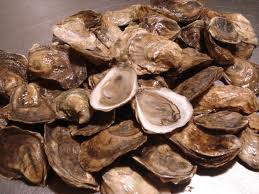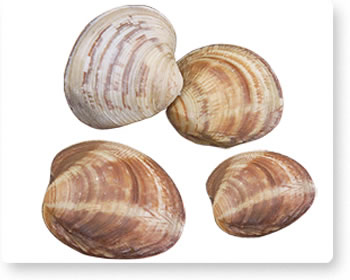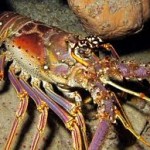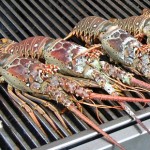FLORIDA OYSTERS
Shellfish harvesting areas are opened and closed in accordance with the National Shellfish Sanitation Program Guidelines, and the open or closed status applies to both recreational and commercial harvest. You may view maps of these areas and determine the open or closed status or get additional information by calling 850-488-5471.
Shellfish harvesting map (click here), click on corresponding 2 digit number on the map for more information.
 Favorite place to get oysters is in the flats of Oak Hill mosquito lagoon. Ask local bait stores for recent harvests and what areas.
Favorite place to get oysters is in the flats of Oak Hill mosquito lagoon. Ask local bait stores for recent harvests and what areas.
- Available year round
- Saltwater license required
- Strong season in fall when water temp drops
- Cool months oysters taste best
- 90% oysters harvested in Apalachicola Bay in Franklin County
- Play critical role in eco system by filtering water 25 gallons a day
- Feed on single cell plants
- Can reach market size in 2 years
- Size must be 3 inches
- 2 bags (60lb) per person/boat – or two 5 gallon buckets with shells
- These counties closed June-August ( Dixie, Levy and Wakulla Counties)
- Seasons closed July-September (all other counties)
- Florida’s top three oyster-producing counties are Franklin, Levy, and Wakulla
- Harvested long-handled tongs to scoop them up from their beds in the shallow water
- Live oysters should close tightly when their shells are tapped
- Discard oysters that do not close shell when tapped
- Don’t store live oysters in water or in ice, no sudden temperature change
- Refrigerate at 41 degrees F, with lid slightly open
- Drain excess liquid from container daily, eat within 7 days of capture
- Wash before cooking
- Diabetes, liver disease, immune disorders or cancer, NO eating raw oysters
- Oysters can be steamed, boiled, oven roasted, baked, grilled, or fried.
- Oysters are highly nutritious, low-calorie, low-cholesterol source of protein
 Cooking Oysters (Shell On)
Cooking Oysters (Shell On)
- Fried in oil at 375 degrees for 3-4 minutes
- Baked 10 mins at 350 degrees until shell opens, middle over rack
- Grill shell on 4 inches from flame until shell opens
- If shucked, bake 10 mins in oven at 450 degrees (no shell on)
- Serving size = 6 oysters or 1/3 to 1/2 pint shucked =80 calories
Clams
 Before cooking, rinse live clams thoroughly under running water. Clams are thoroughly cooked when their shells open and the meat turns plump and opaque. Lean, firm-textured clams are low in fat, cholesterol, and sodium. They provide calcium and iron and are an excellent source of protein
Before cooking, rinse live clams thoroughly under running water. Clams are thoroughly cooked when their shells open and the meat turns plump and opaque. Lean, firm-textured clams are low in fat, cholesterol, and sodium. They provide calcium and iron and are an excellent source of protein
- Harvested year round
- Saltwater License needed
- NO closed seasons
- Grow fast in warm waters, mature at 12-18 months
- Filter feeders cannot handle any water pollution
- Brown hard shell can grow to 4.5 inches long
- Must be 1 inch long across hinge
- 5 gallons per person, or 10 gallons per boat
- Age is marked by rigs and notches on shell, can live to 30 years
- Prominent features foot and neck, foot helps them bury up
- Neck pumps up to 3 gallons of water and hour
- Exceptional nutritious for zinc & omega acids
- Live clams should close tightly when their shells are tapped
- Discard clams that do not close shell when tapped
- Don’t store live clams in water or in ice, no sudden temperature change
- Refrigerate at 41 degrees F, with lid slightly open
- Drain excess liquid from container daily, eat within 7 days of capture
- Wash before cooking
- For open clamming locations, call 850-488-5471
Clamming Links & Video’s
FLORIDA SPINY LOBSTER

 They get their name from spiny shell
They get their name from spiny shell- Color is white to dark, red to orange
- Tickle sticks used to motivate them out of crevices
- NO PINCHER claws
- Long antennae is to scare predators
- Short antennae is using for sensing
- Harvested in Florida Keys
- Spiny lobster must have a minimum carapace length of at least 3 inches
- Must have measuring device with you
- Lobster sport mini season is July 25-26
- Mini season closures in John Pennekamp Coral Reef State Park
- Regular season Aug 6th – End of March
- Mini season limit -6 per person, 12 per person depending on County
- Regular season limit – 6 per person, all legal Counties
- No night diving in Monroe County during mini season
- No harvesting egg bearing females
- No harvesting with tools that can puncture shell
- Required to fly a dive flag
Note: Lobster closures are in Everglades National Park, Dry Tortugas National Park, no-take areas in the Florida Keys National Marine Sanctuary and the Biscayne Bay/Card Sound Lobster Sanctuary during both the two-day season and regular lobster season
During the short sport season, the recreational daily bag limit is six per person in state and federal waters off Monroe County and Biscayne National Park, and 12 per person in state and federal waters off all other counties. During the regular season, the daily bag limit is six per person in all state and federal waters.
Spiny lobster must have a minimum carapace length of at least 3 inches and must be measured in the water. The carapace is measured from the forward edge (between the rostral horns) to the rear edge of the carapace, and all harvesters must have a measuring device while harvesting.
Lobster harvesting during either season requires a resident or nonresident saltwater fishing license and a special lobster permit, unless you are exempt.
 Cooking Tips
Cooking Tips
- Whole lobsters – Put in boiling salted water 12-14 minutes
- Tails boil in salted water only 5-10 minutes
- Brush tail olive oil Grill meat side down, 6 minutes per side
Lobstering Links & Video’s
- How to clean a Florida lobster tail (remove vein)
- How to clean a WHOLE Florida lobster
- Video of 12lb lobster bring caught South Florida
FACEBOOK SHRIMPING/SCALLOPING INTEL
Scalloping reports on Facebook at the “Florida Shrimping Academy – Tips & Tricks™”. CLICK HERE. This is the largest group for shrimping, scalloping, lobstering and gator hunting.
WEBSITE VISITOR’S –





